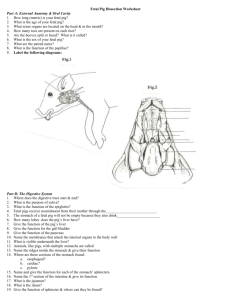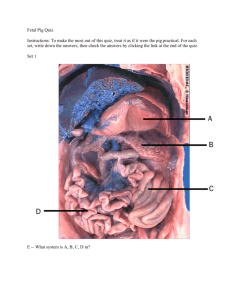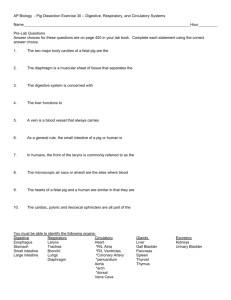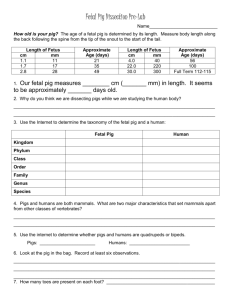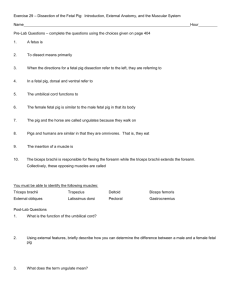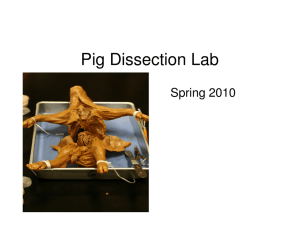Fetal Pig Dissection
advertisement
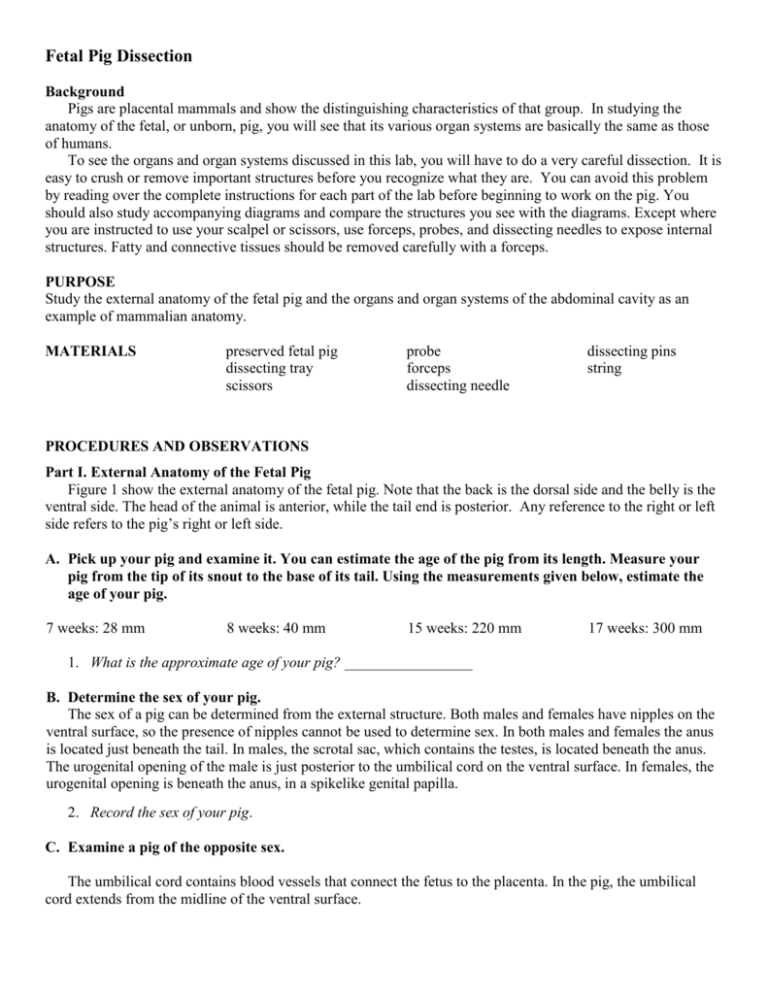
Fetal Pig Dissection Background Pigs are placental mammals and show the distinguishing characteristics of that group. In studying the anatomy of the fetal, or unborn, pig, you will see that its various organ systems are basically the same as those of humans. To see the organs and organ systems discussed in this lab, you will have to do a very careful dissection. It is easy to crush or remove important structures before you recognize what they are. You can avoid this problem by reading over the complete instructions for each part of the lab before beginning to work on the pig. You should also study accompanying diagrams and compare the structures you see with the diagrams. Except where you are instructed to use your scalpel or scissors, use forceps, probes, and dissecting needles to expose internal structures. Fatty and connective tissues should be removed carefully with a forceps. PURPOSE Study the external anatomy of the fetal pig and the organs and organ systems of the abdominal cavity as an example of mammalian anatomy. MATERIALS preserved fetal pig dissecting tray scissors probe forceps dissecting needle dissecting pins string PROCEDURES AND OBSERVATIONS Part I. External Anatomy of the Fetal Pig Figure 1 show the external anatomy of the fetal pig. Note that the back is the dorsal side and the belly is the ventral side. The head of the animal is anterior, while the tail end is posterior. Any reference to the right or left side refers to the pig’s right or left side. A. Pick up your pig and examine it. You can estimate the age of the pig from its length. Measure your pig from the tip of its snout to the base of its tail. Using the measurements given below, estimate the age of your pig. 7 weeks: 28 mm 8 weeks: 40 mm 15 weeks: 220 mm 17 weeks: 300 mm 1. What is the approximate age of your pig? _________________ B. Determine the sex of your pig. The sex of a pig can be determined from the external structure. Both males and females have nipples on the ventral surface, so the presence of nipples cannot be used to determine sex. In both males and females the anus is located just beneath the tail. In males, the scrotal sac, which contains the testes, is located beneath the anus. The urogenital opening of the male is just posterior to the umbilical cord on the ventral surface. In females, the urogenital opening is beneath the anus, in a spikelike genital papilla. 2. Record the sex of your pig. C. Examine a pig of the opposite sex. The umbilical cord contains blood vessels that connect the fetus to the placenta. In the pig, the umbilical cord extends from the midline of the ventral surface. D. Examine the cut end of the umbilical cord. You should be able to see two arteries and a vein. The vein may be completely collapsed, which makes it difficult to find. If you cannot find the vein, make a fresh cut through the cord about 1 centimeter from the body wall, and examine the freshly cut end. 3. Draw a cross section of the umbilical cord and label the blood vessels. E. Examine the feet of the pig. 4. How many toes does the pig have? ________________ 5. How are the toes positioned on the foot? F. Examine the mouth and teeth of the pig. CAUTION: Dissecting implements are very sharp. Use extreme care. Using your scissors, cut the corners of the jaw so that the mouth will remain open. Locate the following structures and label them on your diagram page: nares, tongue, nasopharynx, glottis, epiglottis, hard palate, soft palate, and the opening of the esophagus. Part II: Opening the Abdominal and Chest Cavities The Abdomen – Digestive System A. Place the pig on its back in the dissecting tray. Tie a piece of string around the “wrist” of one of the front legs. Run the string under the dissecting tray and tie it around the writs of the other front leg. Pull the string fairly tight so that the legs are spread apart. Do the same with the hind legs. B. Figure 2 shows where your incisions should be made. In making incisions, use only ythe tip of your scalpel and do NOT press down hard. Be particularly careful n the incision over the chest area. Begin the incision just above the umbilical cord (marked by a dot) on line 1. Then make the incision shown by line 2, and so on. The ends of the diaphragm, the muscle that separates the abdominal and chest cavities, are attached to the body wall. C. Gently pull apart the flaps of the body wall along the long incision between the front and hind legs. Do NOT lift the flap with the umbilical cord. As you separate the flaps under the front legs, carefully cut the ends of the diaphragm at the body wall so that the flap can be pinned down. D. Carefully pull up the flap with the umbilical cord a little ways. You will see the umbilical vein extending from the inside of the umbilical cord up through the liver, toward the head. To pull up this flap, you have to cut the umbilical vein. Do NOT cut off the flap. After cutting the vein, just leave the flap extending backward between the hindlegs of the pig. E. The organs of the abdominal cavity are covered by a membrane called the peritoneum. When you pulled apart the flaps of the body wall to expose the abdominal cavity, some of the peritoneum may have been pulled off. If not, carefully slit the peritoneum and then use your forceps to pull it off the organs of the abdomen. F. Examine the liver, both the upper and lower surfaces. Locate the gall bladder on the undersurface. Very carefully use your forceps to remove the peritoneum covering the gallbladder. Trace 1. How many lobes does the liver have? ____________________________________________________ 2. Describe the location and appearance of the gallbladder. ___________________________________ ____________________________________________________________________________________ 3. Describe what happened to the duct from the gallbladder. Did it join other ducts? Where did the duct(s) end? ________________________________________________________________________ ____________________________________________________________________________________ 4. What does the liver do for the pig? Check your reference packet. ___________________________ 5. What organ systems does the liver belong to? _____________________________________________ G. Identify the stomach. The long flattened reddish organ that lies under the outer curve of the stomach is the spleen. Find the junction of the stomach and the esophagus. Then find where the stomach joins the small intestine. Carefully slit open the upper surface of the stomach, beginning where it joins the esophagus and extending to the junction of the small intestine. Examine the inner surface of the stomach, particularly where it joins the esophagus and small intestine. 4. Can you trace the esophagus very far from the stomach? Why or Why not? ___________________ ____________________________________________________________________________________ 5. Was the material that you found in the stomach food? How do you know? ____________________ ____________________________________________________________________________________ 6. Describe the inner surface of the junction of the stomach and esophagus. What structure did you find at this point? ____________________________________________________________________ ____________________________________________________________________________________ 7. Describe the inner surface of the junction of the stomach and small intestine. What structure did you find at this point? ________________________________________________________________ ____________________________________________________________________________________ 8. What is the function of the small intestine? _______________________________________________ H. Lift up the stomach and locate the pancreas. It is a whitish organ with a granular surface. The pancreatic duct extends from the end of the pancreas nearest the small intestine into the small intestine. However, it is very small and difficult to find. 1. What does the pancreas do? __________________________________________________________ I. Examine the small intestine, beginning at its junction with the stomach. Spread apart some of the coils of the intestine and note the mesentery, a membrane that holds the intestine in place. Blood vessels and nerves also run through the mesentery. Find the junction of the small and large intestines. Identify the caecum (appendix), a small pouch. Find the large intestine, a tube that is spiraled. 9. How do the small and large intestine differ in external appearance? _________________________ ____________________________________________________________________________________ PART III. The Respiratory and Circulatory system A. Open the thoracic cavity, using scissors to cut through the bone. The bones are very soft, therefore, when cutting through them, be careful not to cut too deeply or you will damage the heart and lungs. Using scissors, carefully cut the diaphragm on either side of the body, and fold it back over the liver. B. Beginning at the top of the stomach, trace the esophagus as it passes through the diaphragm and under the heart. At the anterior end of the esophagus on the ventral side is the trachea. Notice the rings of cartilage that surround the trachea. What is their function? ________________________________ ________________________________________________________________________________ These rings give the trachea the appearance of a vacuum cleaner hose. Trace the trachea to the point at which it branches to each lung. C. Continue the dissection of the neck anteriorly to find an enlarged area of cartilage. This is the larynx, often called the voice box. At the top of the trachea is the epiglottis, which you located when observing the mouth structures. What is the function of the epiglottis? __________________________________ ___________________________________________________________________________________ D. Using the diagram, locate and label the right lung, left lung, and the heart, which is enclosed in the pericardium. Remove the pericardium from the heart. Draw a diagram of the heart. Label the following structures on the ventral side of the heart: right atrium, left atrium, right ventricle, left ventricle, coronary blood vessels. What is the function of the coronary blood vessels?______________ ____________________________________________________________________________________ E. Turn the heart onto the dorsal side without removing it. Locate and label the two major veins that bring blood back to the heart, the superior vena cava and inferior vena cava. Locate and label the right and left pulmonary veins. This is the pair of veins that brings blood back to the heart from the lungs. Both of these empty into the left atrium. F. Carefully dissect around the heart, picking away the connective tissue between the blood vessels. Locate and label the pulmonary artery, on the ventral side of the heart, as it leaves the right atrium. The aorta, the largest and most important artery, can be found just beneath the pulmonary artery as it leaves the left ventricle. Very careful dissection will allow you to find the ductus arteriosus, a short connecting vessel that functions in the fetus to shunt blood away from the pulmonary artery directly into the aorta. This vessel slows most of the blood to bypass the lungs. Why would this be important to a fetal animal? ___________________________________________________________________________________ ___________________________________________________________________________________ G. PART IV. The Urogenital System MALE FEMALE A. The organs of the excretory and reproductive systems will now be exposed. As the organs of the urogenital system are described and located, label each of them on the diagram. The kidneys are the pair of dark, bean-shaped organs lying on the dorsal wall, behind the peritoneum. The kidneys are supplied with blood by the renal arteries. The renal veins take blood away from the kidneys. They are located just below the renal arteries. 1. What do the kidneys do? ________________________________________________________ 2. What system are the kidneys in? __________________________________________________ B. Coming from the posterior end of the kidney is the ureter. This is the tube that drains urine from the kidney into the urinary bladder for storage. Trace the ureter to the bladder. Cut through the cartilage of the pelvic girdle with scissors. Spread the legs and pelvic girdle as far apart as possible. Locate the urethra, which comes from the urinary bladder to the urogenital opening, through which urine is eliminated from the body. C. The Male Reproductive System Depending on the age of the male fetus you will find the oval-shaped testes either in the abdominal cavity or inside the scrotal sacs at the posterior of the pig. On each testis find the coiled epididymis. What is the function of the epididymis? __________________________ ___________________________________________________________________________________ The vas deferens carry the sperm from the epididymis to the urethra. Follow the urethra to the penis, a muscular tube carrying both reproductive cells and liquid wastes out of the body. The urethra goes all the way through the inside of the penis. D. The Female Reproductive System: Locate the two ovaries at the posterior end of the abdominal cavity of the female fetus. Each ovary has a coiled, tube-like structure called the oviduct. What is the function of the oviduct? ____________________________________________________ E. Trace the path of the oviduct to the uterus where the fertilized egg develops into an embryo and later a fetus. The muscular tube just posterior to the uterus is the vagina. In the pig, the vagina opens into an area called the urogenital sinus that opens to the outside of the body through the urogenital opening, just ventral to the anus. Label more structures on your diagram page, using what you know. PART V. The Nervous System The nervous system of the pig is very similar to that of humans. There is the central nervous system consisting of the brain and spinal cord and the peripheral nervous system consisting of cranial and spinal nerves and their branches. A. Make incisions through the skin of the head as shown in figure 4. Peel off the skin. Look for lines in the skull which indicate where the bones meet. Carefully insert the pointed end of your scissors between the bones. Then use the tips of your forceps to pull or break off pieces of the skill until you have opened up most of the skinned area. The brain and spinal cord are protected by three membranes known collectively as the meninges. The outermost of these membranes which is just beneath the skull, is called the dura mater. It is the thickest and toughest of the membranes. The surface of the brain is covered by a thin membrane called the pia mater. The third membrane, called the arachnoid membrane, is found between the dura mater and pia mater. In living animals cerebrospinal fluid fills the space between the two inner membranes. In preserved specimens, the two inner membranes both adhere to the surface of the brain. B. Cut through the dura mater, exposing the brain. See Figure 5. Identify the right and left cerebral hemispheres. Notice the deep longitudinal fissure between them. Identify the cerebellum, which is behind and beneath the cerebrum. Try to identify the medulla, which is behind and beneath the cerebellum. You may remove parts of the brain after you have identified them. In front of (anterior to) the cerebral hemispheres are the olfactory lobes, which are the brain centers for the sense of smell. Try to locate the olfactory lobes in your pig. 1. Name the parts of the brain that you identified in your pig and describe the external appearance of each. _______________________________________________________________________________________ _______________________________________________________________________________________ _______________________________________________________________________________________ _______________________________________________________________________________________ SUMMARY QUESTIONS – Fetal Pig Dissection 1. Name the major mammalian characteristics that are exhibited by the fetal pig ___________________________________________________________________________________ ___________________________________________________________________________________ 2. Name the organs and structures of the digestive system in the order that food moves through them. ___________________________________________________________________________________ ___________________________________________________________________________________ 3. What other organs and structures are part of the digestive system? ___________________________________________________________________________________ ___________________________________________________________________________________ 4. Name the organs and structures of the respiratory system in order from the mouth to the lungs. ___________________________________________________________________________________ ___________________________________________________________________________________ 5. Name the blood vessels and heart structures that make up the circulatory system in order, beginning with the superior vena cava and inferior vena cava. ___________________________________________________________________________________ ___________________________________________________________________________________ ___________________________________________________________________________________ ___________________________________________________________________________________


